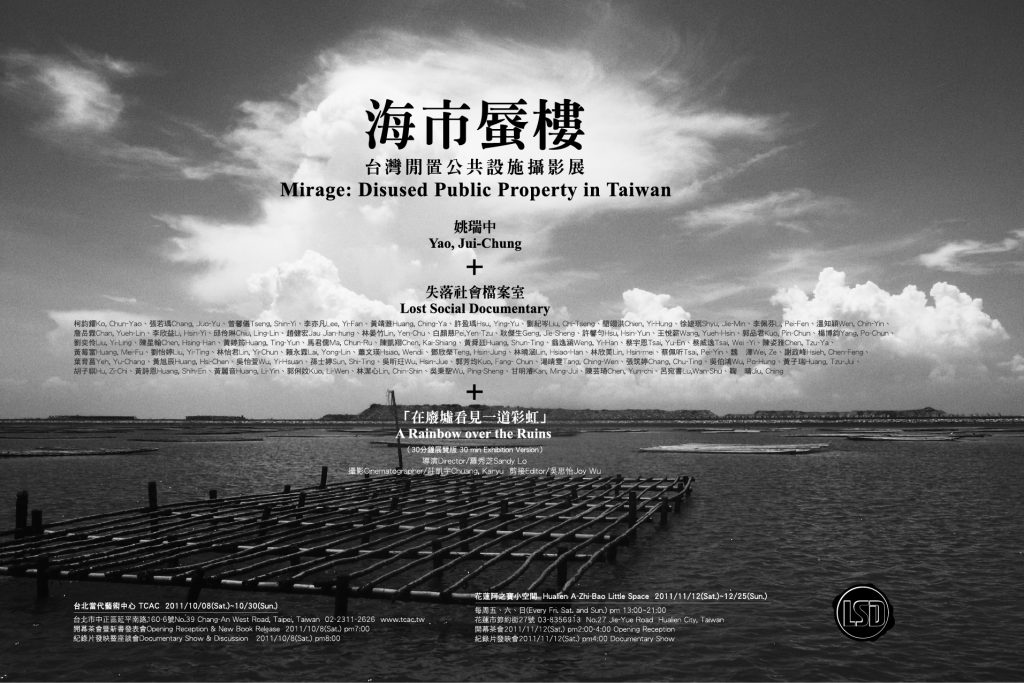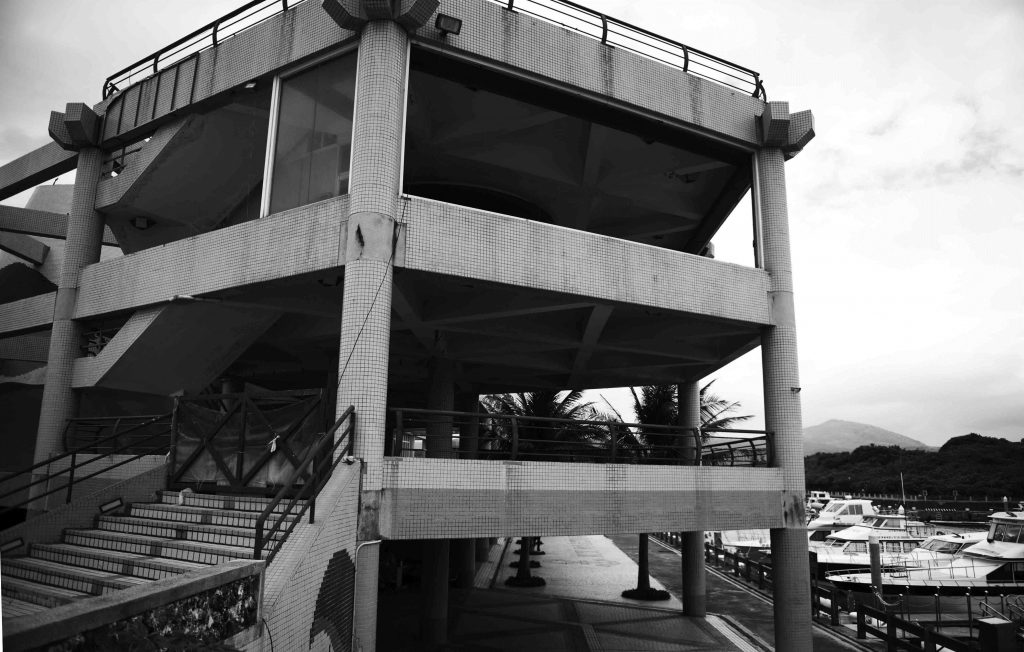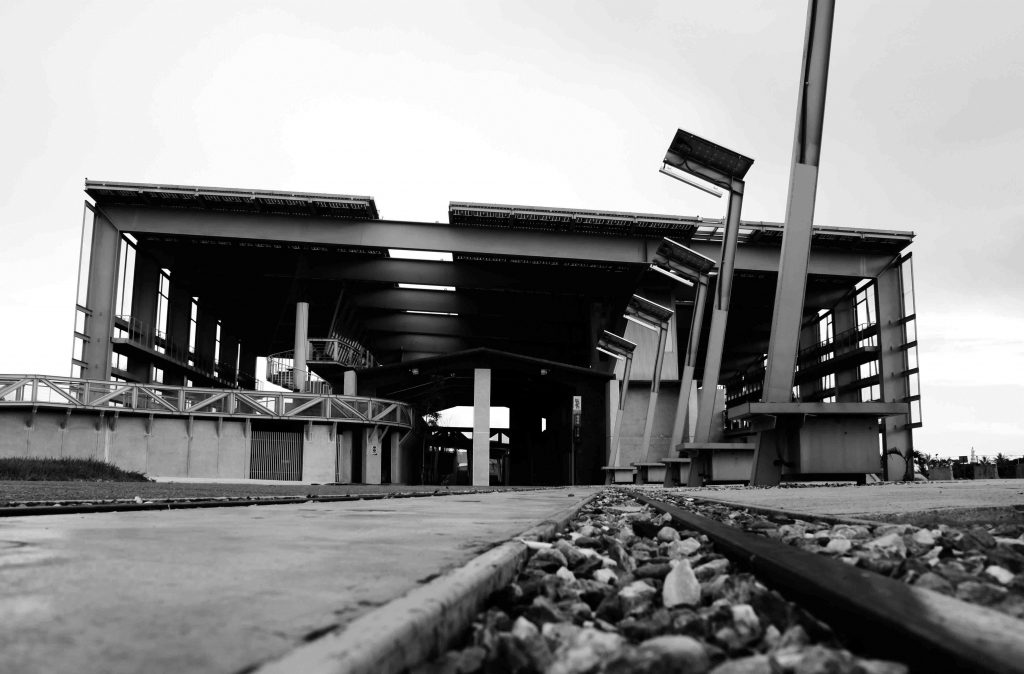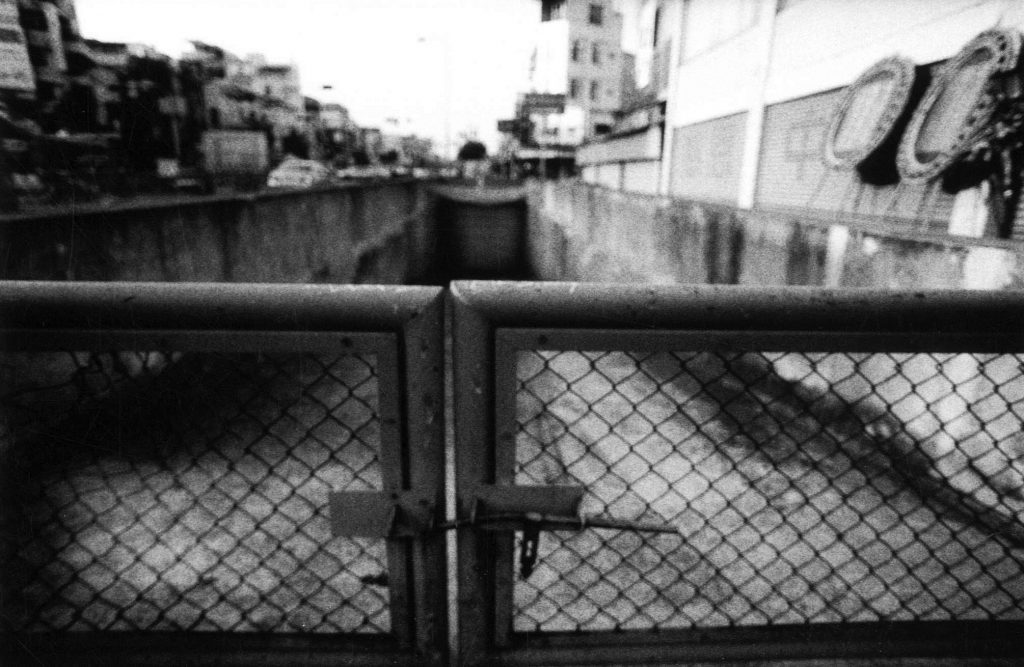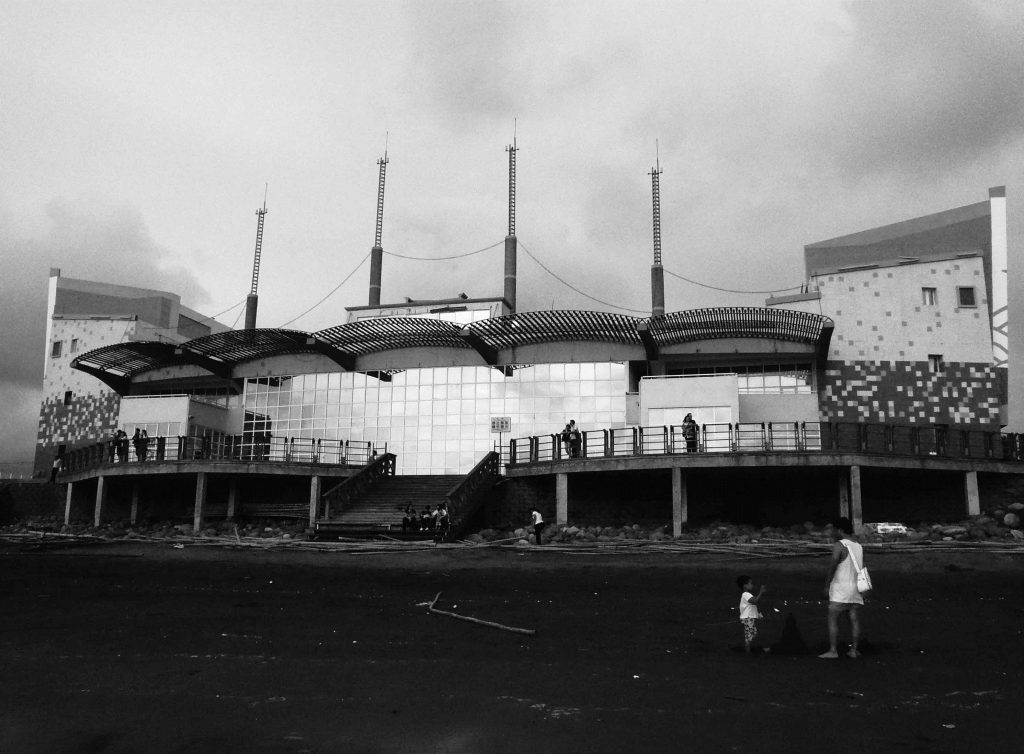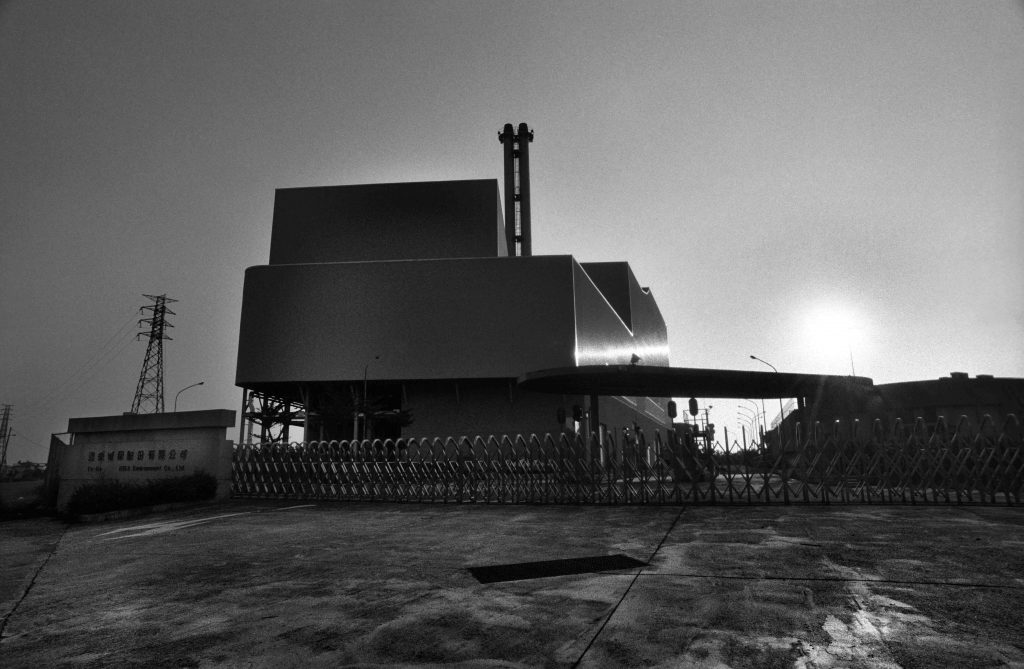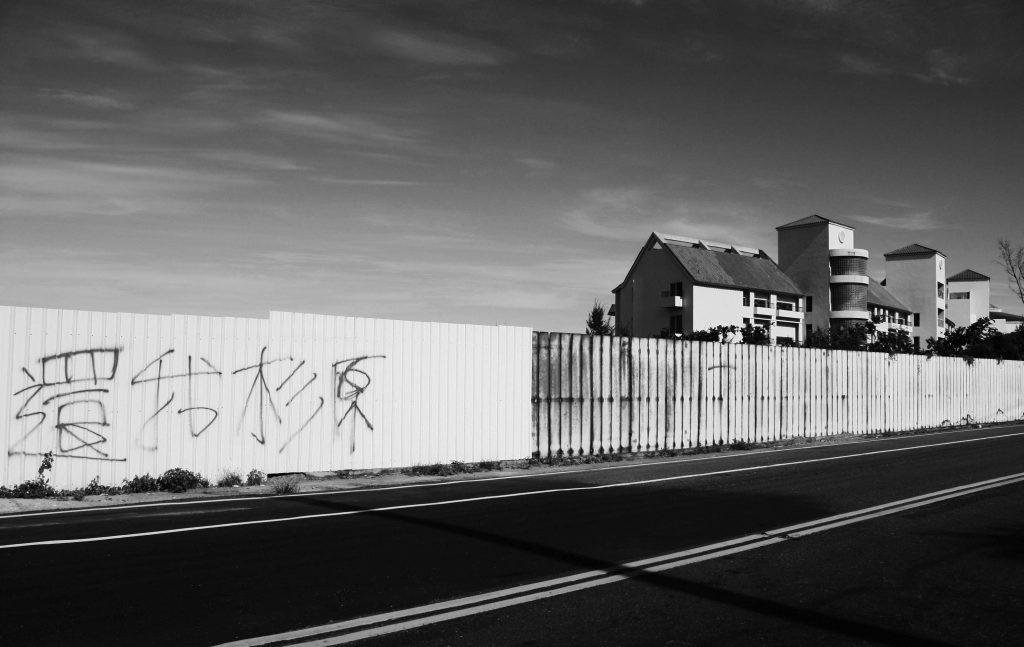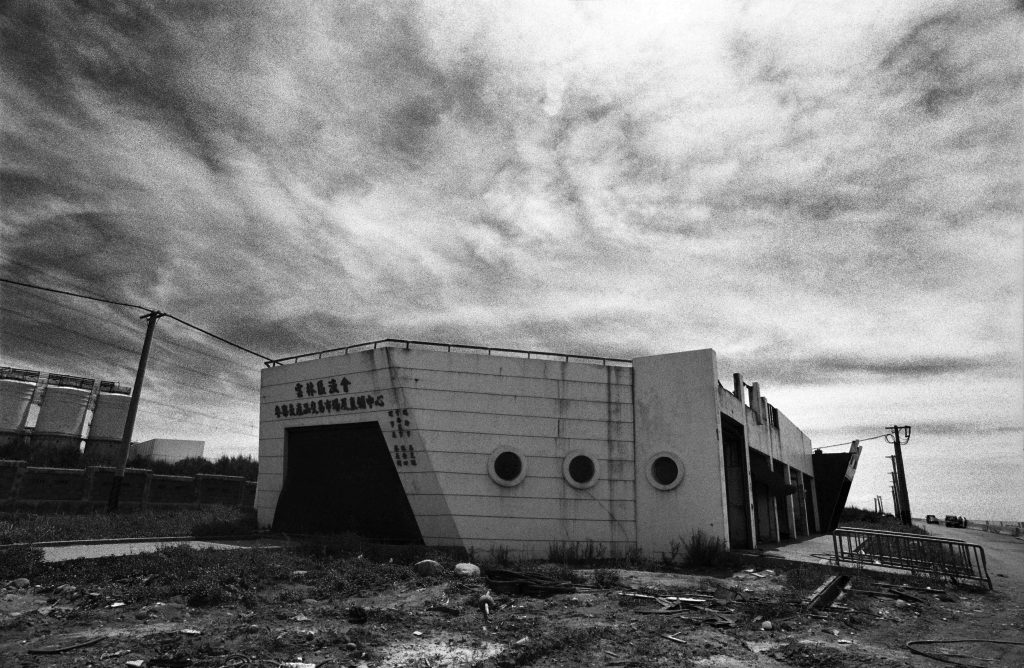海市蜃樓
台灣閒置公共設施攝影展
Mirage: Disused Public Property inTaiwan
+
失落社會檔案室Lost Social Documentary
柯鈞耀Ko, Chun-Yao、張若瑀Chang, Juo-Yu、曾馨儀Tseng, Shin-Yi、李亦凡Lee, Yi-Fan、黃靖雅Huang, Ching-Ya、許盈瑀Hsu, Ying-Yu、劉紀岑Liu, Chi-Tseng、簡翊洪Chien, Yi-Hung、徐婕玟Shyu, Jie-Min、李佩芬Li, Pei-Fen、溫知穎Wen, Chih-Yin、詹岳霖Chan, Yueh-Lin、李欣益Li, Hsin-Yi、邱伶琳Chiu, Ling-Lin、趙健宏Jau Jian-hung、林晏竹Lin, Yen-Chu、白顏慈Pei,Yen-Tzu、耿傑生Geng, Jie-Sheng、許馨勻Hsu, Hsin-Yun、王悅薪Wang, Yueh-Hsin、郭品君Kuo, Pin-Chun、楊博鈞Yang, Po-Chun、劉奕伶Liu, Yi-Ling、陳星翰Chen, Hsing-Han、黃婷筠Huang, Ting-Yun、馬君儒Ma, Chun-Ru、陳凱翔Chen, Kai-Shiang、黃舜廷Huang, Shun-Ting、翁逸涵Weng, Yi-Han、蔡宇恩Tsai, Yu-En、蔡威逸Tsai, Wei -Yi、陳姿雅Chen, Tzu-Ya、黃莓富Huang, Mei-Fu、劉怡婷Liu, Yi-Ting、林怡君Lin, Yi-Chun、賴永霖Lai, Yong-Lin、蕭文瑛Hsiao, Wendii、鄧欣榮Teng, Hsin-Jung、林曉涵Lin, Hsiao-Han、林欣美Lin, Hsin-mei、蔡佩聽Tsai, Pei-Yin、魏 澤Wei, Ze、謝政峰Hsieh, Chen-Feng、葉育菖Yeh, Yu-Chang、黃旭辰Huang, Hsi-Chen、吳怡萱Wu, Yi-Hsuan、孫士婷Sun, Shi-Ting、吳昕玨Wu, Hsin-Jue、郭芳均Kuo, Fang- Chun、湯晴雯Tang, Ching-Wen、張築婷Chang, Chu-Ting、吳伯鴻Wu, Po-Hung、黃子瑞Huang, Tzu-Jui、鬍子祺Hu, Zi-Chi、黃詩恩Huang, Shih-En、黃麗音Huang, Li-Yin、郭俐妏Kuo, Li-Wen、林潔心Lin, Chin-Shin、吳秉聖Wu, Ping-Sheng、甘明濬Kan, Ming-Jui、陳芸琦Chen, Yun-chi、呂宛書Lu,Wan-Shu、鞠 晴Jiu, Ching
+
「在廢墟看見一道彩虹」(30分鐘展覽版)
A Rainbow over the Ruins (30 min Exhibition Version)
導演Director/羅秀芝Sandy Lo
攝影Cinematographer/莊凱宇Chuang, Kai-yu 剪接Editor/吳思怡Joy Wu
台北當代藝術中心 TCAC 2011/10/8(Sat.)-10/30(Sun.) 每週二-週日 1-7pm
開幕茶會暨新書發表會Opening Reception & New Book Release : 2011/10/8(Sat.) pm7:00
紀錄片發映暨座談會Documentary Show & Discussion : 2011/10/8(Sat.) pm8:00
台北市中正區延平南路160-6號No.39 Chang-An West Road, Taipei, Taiwan 02-2311-2626 www.tcac.tw
花蓮阿之寶小空間 Hualien A-Zhi-Bao Little Sspace
2011/11/12(Sat.)-12/25(Sun.) 每週五、六、日(every Fri. Sat. and Sun.) pm 13:00~21:00
花蓮市節約街27號 03-8356913 No.27 Jie-Yue Road Hualien City, Taiwan
開幕茶會Opening Reception:2011/11/12(Sat.) pm2:00-4:00
紀錄片發映會Documentary Show:2011/11/12(Sat.) pm4:00
[youtube]http://www.youtube.com/watch?v=j5Rqbzovr1w[/youtube]
———————————
新書編者序
基於2010年九月出版的「海市蜃樓-台灣公共閒置設施抽樣踏查」一書,尚未完整描繪公共閒置設施面貌,因此自2010年十月再次動員約七十位學生下鄉踏查,補充遺漏案例。仍以國立台北藝術大學與國立師範大學二所學校的美術係為主,另有一些自告奮勇的外系或外校學生主動參與,多數學生都是所謂的攝影素人,他們以有限的設備利用課餘時間走訪全國各地,再從約二百個踏查地點中抽樣出一百一十一個案例(包括十一處活化案例),彙編成「海市蜃樓Ⅱ-台灣公共閒置設施抽樣踏查」,透過文字與照片呈現社會發展的特殊現像,以公民參與的方式提醒社會大眾,並提供政府有關部門參考。
本書第一篇十一個章節所收錄的一百處案例,包括延宕開發的大型園區、蓋到一半卻停工而閒置的設施、新建卻缺乏實質效益的建設、經營管理不佳的館舍、功成身退仍堪用的閒置空間……等,多數文字資料參考自監察院、審計部資料及招標網站,或彙整比對相關報導並實際走訪拍攝而成。第二篇收錄的十一個案例,包括原有功能成功活化、變更用途而活化、撥給慈善或非營利組織完善使用、解除列管但活化有限、一直處於活化與閒置之間、完全拆除…等實例,過去一年,政府相關部門的確活化了部份閒置空間,雖然作法有待檢驗,仍值得納稅人欣慰;而工程會在新任主委掌舵之後,陸續宣佈活化措施,包括控管源頭、將部份閒置空間改裝為青年住宅,並擋下了五十三件可能成為「蚊子館」的「孓孒館」(指有可能成為「蚊子館」的新建工程),其大刀闊斧的做法,值得賀彩,但在2012年總統大選之後這些「孓孒館」是否復活,則尚待觀察。
值得注意的是,根據審計部九十八年度報告指出,至2009年五月底為止,國防部閒置營區共有四百二十二處,佔地十分廣闊,其閒置原因主要是因為國軍調整軍事部署,加上戰爭形態改變,許多軍事設施已無法滿足現代電子化的作戰需求,而導致大量廢置,其中八十一處已同意釋出,不過尚未完成法定程序或辦理移交。而教育部管轄的國民中小學廢併校舍二十六所,皆無活化措施,在少子化趨勢下,未來恐怕只會更多。至於國營事業的重大投資計劃、設備閒置或未達經濟效益者有五十一件,其它有待評估的中小型建設與開發案更是多如牛毛,恐怕連中央或地方政府自己也不太清楚。
近年來另有一個奇特現象,即全國各地如雨後春筍冒出的「╳╳園區」。「產業園區化」已是目前顯學,好像要振興產業就非得要更多土地、更廣闊的空間、更龐大的經費,這些以「產業休閒化」、「文化產業化」為主導的政策,如今已全面地逐步整合產官學界,在公辦民營風氣趨勢下,政府動輒以美好藍圖徵收民地或改建閒置空間,大舉興建供需失衡的各式園區(保守估計全台約有上百座),學者爭相投標規劃案或研究案已司空見慣,許多以學術著稱的院校也相繼投入經營,更別說大財團早已佔盡有利位置,以高明的政商關係層層轉包、分食大餅。
姑且不論這些園區可能帶來的產值與產能,或這些圈地型建設導致與在地關係的斷裂,在政黨利益高於人民利益的政治算計下,選前吸票、選後酬庸的模式一再上演,與當年為數眾多、但大多只有單一空間的「蚊子館」相比,如今動輒包含數十棟建築物的龐大園區更具獲利潛力。當政府全面掌控資源與財團合作,並以堂而皇之的理由開發,由原本的正義分配轉變成有條件的分配,其所共謀的核心並不在於真正落實民間的自主發展,而在於此類計劃型園區內可操控的漂亮數據、搏版面的致詞剪綵、給予幸福許諾的康樂活動,有時再加入一些置入性政策行銷,園區就像是一座樣品屋或充滿佈景的主題樂園,參觀者皆不自覺地成為臨時演員,而變成操盤者換取更多籌碼的本錢。
以上這些現象不得不令人納悶,台灣在過去幾年處理社會轉型的過程中,出現了不少轉型不正義的現像,而更多的巨大建設是否等同於產能與產值?對於社會價值觀乃至於文化發展是否有無形影響呢?
事實上,台灣並不缺乏更多的公共空間,到處都是╳╳會館、╳╳文化館、╳╳中心、╳╳園區…,反而是過多的常民空間稀釋了專業性空間產生的可能,形成了財政上巨大負擔還是其次,專業人才無法盡展所長才是問題核心,例如「資本門」(有形資產)通常就佔去百分之七、八十的預算,只餘少數的「經常門」(軟體開銷)運用,不足處須向有關單位申請補助,在只補助部份經費的潛規則之下,往往導致常態性業務縮編或觸礁,許多低度使用的館舍就是這樣形成的,是否應建立退場機制,逐步提昇有口皆碑的績優館舍(有專業形象、具研究開發能力、不以參訪人數為唯一考量依據)營運資源,也許是條亡羊補牢的途徑。
在如今以產值掛帥的功利社會中,許多非營利組織、弱勢族群、社福機構與慈善團體、實驗性藝文展演團體與工作室…,更需要政府的支持與協助,若能釋放部份公有閒置空間或經營不善的館舍,例如台北市文化局所推動的「藝饗計劃」即陸續釋放市轄閒置空間,交由民間專業藝文團體使用,使上游創作端的研發較無後顧之憂,對於目前政府正在大力推廣展演平台(例如全國各地的文化創意園區),而缺乏支持後端的生產者而言,能夠釋放效能低落的空間(如停車場、市場…)改裝為租金低廉的工作室,未嘗不是一個雙贏的局面。
好大喜功固然是全世界執政當局普遍的心態,但台灣的執政者向來習慣以「加法」概念大舉興建公共建設、吹噓政績、綁樁固票,若能以「減法」概念思考,從上游審慎審議、中游嚴格控管、下游落實退場,去除環境不必要的負擔,或接受已成為事實的閒置空間,以有限資源作積極運用,讓這些負資產轉成正面能量,使人才得到適當發揮,當為全民之福。
————— ————– ————– ————– ————– ————– ————– ————–
Since the book Mirage: Disused Public Property in Taiwan published in September 2010 did not depict a complete picture of the public constructions left unused, in October 2010, about seventy students set of again to carry out investigation in rural areas to supplement similar cases left out. The participants were mainly students from the school of fine arts of Taipei National University of the Arts and National Taiwan Normal University, while some of them were volunteer from other departments or schools. With most of them being amateur photographers, they journeyed around the country during extracurricular time with their limited equipment. Then they picked a hundred and eleven out from about two hundred cases (including eleven cases of rejuvenation) to form the Mirage II: Disused Public Property in Taiwan, which presented unusual phenomena of social development with words and photos, reminded the public by ways of civic engagement, and provide the authorities concerned with references.
The eleven chapters in the first part of the book include one hundred cases including major parks with their construction postponed, structures built only halfway, newly completed constructions with little practical use, poorly managed buildings, sites deserted but still in shape…Most of the information was written based on the data of the Control Yuan and the National Audit Office and bidding websites or completed by gathering related reports and taking photos. The eleven cases in the second part included constructions that were rejuvenated, renewed with different functions, given to charity or non-profit organizations, with restraints lifted but little rejuvenation, or totally demolished…
What is notable is that, according to the annual report of the National Audit Office in 2009, the Ministry of National Defense has four hundred and twenty-two disused camps by the end of May 2009, which account for a rather big amount of land. The idleness is mainly due to the adjustment of military deployment
There has been a strange phenomenon in recent years, which is that a lot of “parks” mushroomed around the country. Industrial parks is a current trend. It seems as if that industries cannot be boosted without a lot of land, space, and money. The policies in the name of “industries recreationalizing” and “culture industrializing” have now comprehensively arranged and combined industries, authorities, and academia. With them being led by administrations and operated by the public, the government can easily confiscate public land or rebuild idle spaces for their projects, and they have extravagantly and exceedingly built all kinds of parks (, estimated to have amounted more a hundred ones.) Scholars compete to propose projects or research, and many institutes and colleges known academically started to invest. And major corporations, furthermore, have long ago taken a lot of advantages of their relationships with political sectors to gain profit by strategically dividing up constructions.
Even if not to regard the proceeds and functions of the parks or the gap in their relations with the locals, we can still see that, at the time when political parties’ interests are more important those of people’s, politicians try very eagerly to draw people’s votes. And obviously, the enormous parks comprised by scores of buildings possess more potential to profit compared with the single disused in the past. When the government completely takes control of resources, collaborates with profit groups, and develops with indisputable reasons, the initially righteous distribution turns to be conditional. Also, the key purpose of these planned parks is not realizing civil independent development but manipulating impressive data, giving speeches,
During the past few years when Taiwan dealt with social changes, many injustice phenomena occurred. These phenomena make us wonder if having more grand constructions definitely equals to growth in proceeds and functions and whether they cause invisible influences on social values or even on the development of culture.
In fact, Taiwan does not need any more public space. While different assembly halls, institutes, centers, or parks can be seen everywhere, places for the general public usually thin the possibility of constructing professional spaces, leading to enormous financial burden and, moreover, the inability of professionals to apply their talent. For example, capital expenditure (on tangible assets) often takes up 70 to 80 percent of budgets, and only the rest of budgets can be used for current expenditure (on software). If people apply for subsidies with authorities concerned, only part of the funds can be acquired, leading to the reduction or difficulties of regular affairs and many idle constructions. One way to mend the loss may be improving gradually the managing resources of some well-known quality structures (witch possess professional images and abilities to conduct research and do not view the number of visits as their only indicator.)
In nowadays society where output value is highly emphasized, many non-profit organizations, disadvantaged groups, institutions of social welfare, charitable organizations, experimental exhibition groups, and studios… need more support and assistance from the government. Part of the idle space or unorganized buildings can be released to non-governmental art groups, for example, the project promoted by the Bureau of Culture of Taipei is gradually giving out city-governed idle spaces. In this way, the creators at the upper stream do not have to worry much about spaces for events. and it is also a help for the producers of the exhibition platforms. In addition, the distribution of exhibition platforms may also be helpful to producers who lack support. Therefore, if places of low efficiency (such as parking lots, markets…) can be reconstructed into a studio of low rent, it may be a win-win situation for both producers and consumers in industries.
It is common for a government to pursue grand feat, and Taiwanese authorities have been used to boasting about their achievements and securing their votes by “adding” a lot of public constructions. However, they can probably think about “subtracting” the burden on the environment by careful consideration, strict enforcement, and finally actual practices. Also they can view the unused spaces and effectively apply the limited resources. By these ways, the debt can be turned in to positive forces, and the talented can have chances to contribute their abilities.
部份展出圖檔 Parts of the images on display
斥資八千二百多萬元的雲林縣箔子寮漁港產品直銷中心只有一間廠商營業
斥資八億六千多玩元興建的屏東縣後壁湖遊客中心因官商糾紛暫停營運
斥資十一億元的屏東九如航空站已停止營運
斥資四千五百萬元的雲林縣北港果菜市場辦公大樓及拍賣交易場仍是廢墟一座
斥資四億四千萬元的花蓮市洄瀾之心陽光電城
斥資超過二億元的台北市建成圓環已數度活化皆告失敗
斥資數億元擴建的國立臺灣美術館典藏庫工程目前仍是一個大工地
由花費百億元興建的雲林離島式基礎工業區新興區上遠眺麥寮六輕
花了三千四百萬元開挖而無法運作的台中市後裡區(原台中縣後裡鄉)垃圾衛生掩埋場
花費二十五億元的台南海安路地下街廢墟
花費二億一千多萬元興建的桃園縣北區綜合展示館仍是荒蕪一片
花費二億三千萬元的台南市鯤喜灣文化園區遊客中心
花費二億元的望將大橋橋墩
花費三十三億元的雲林縣林內焚化爐
花費三億五千萬元的台東縣杉原美麗灣度假村在縣府護航下通過開發引起民怨
花費六億七千九百萬元的金門文化園區
已成廢墟的雲林縣麥寮鄉六輕北堤魚貨批發市場及直銷中心
嘉義縣故宮南院願景館
綠島人權紀念園區內已荒廢近十年的技能訓練所

